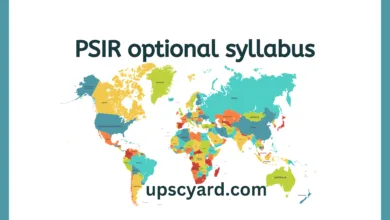For booklist and strategy Click here
UPSC Anthropology optional syllabus
In the UPSC Mains examination, the Anthropology optional subject consists of two papers, namely Paper I and Paper II. Each paper carries 250 marks, resulting in a total of 500 marks for the Anthropology optional subject.
The UPSC offers a list of 48 optional subjects for the IAS Exam, and one of them is Anthropology. When preparing for the UPSC Anthropology syllabus, the emphasis is on candidates’ understanding of the subject as a scientific discipline and their ability to apply that knowledge to real-world issues. The topics covered in Anthropology include human evolution, social structures, and cultural evolution and development. By studying these areas, candidates gain insights into how societies have evolved over time and the challenges they face. Understanding Anthropology helps candidates analyze and provide solutions to the problems encountered by different communities.
For UPSC Mains aspirants who have opted for Anthropology as their optional subject, thorough preparation is of utmost importance. It is essential to study previous years’ question papers and refer to relevant books on Anthropology for UPSC in order to build a strong foundation. Additionally, IAS aspirants can benefit from integrating their Anthropology optional preparation with their General Studies studies, both in the preliminary and mains exams, as there exists a significant overlap in the syllabus of these subjects.
By adopting this integrated approach, candidates can streamline their preparation efforts and optimize their chances of success in the UPSC examination. This method allows for efficient utilization of study time and resources, ensuring comprehensive coverage of the required topics in Anthropology while simultaneously strengthening the understanding of General Studies concepts. Such a holistic approach enhances the overall preparation strategy and increases the likelihood of achieving a favorable outcome in the UPSC Mains.
UPSC Anthropology optional syllabus
Paper 1
- Meaning, Scope and development of Anthropology.
- Relationships with other disciplines : Social Sciences, behavioural Sciences, Life Sciences, Medical Sciences, Earth Sciences and Humanities.
- Main branches of Anthropology, their scope and relevance :
- Social-cultural Anthropology.
- biological Anthropology.
- Archaeological Anthropology.
- Linguistic Anthropology.
- Human Evolution and emergence of Man :
- Biological and Cultural factors in human evolution.
- Theories of Organic Evolution (Pre-Darwinian, Darwinian and Post-Darwinian).
- Synthetic theory of evolution; Brief outline of terms and concepts of evolutionary biology (Doll’s rule, Cope’s rule, Gause’s rule, parallelism, convergence, adaptive radiation, and mosaic evolution)
- Characteristics of Primates; Evolutionary Trend and Primate Taxonomy; Primate Adaptations; (Arboreal and Terrestrial) Primate Taxonomy; Primate Behaviour; Tertiary and Quaternary fossil primates; Living Major Primates; Comparative Anatomy of Man and Apes; Skeletal changes due to erect posture and its implications.
- Phylogenetic status, characteristics and geographical distribution of the following :
- Plio-preleistocene hominids inSouth and East Africa—Australopithecines.
- Homo erectus : Africa (Paranthropus), Europe (Homo erectus (heidelbergensis), Asia (Homo erectus javanicus, Homo erectus pekinensis.
- Neanderthal man—La-chapelle-aux-saints (Classical type), Mt. Carmel (Progressive type).
- Rhodesian man.
- Homo sapiens—Cromagnon, Grimaldi and Chancelede.
- The biological basis of Life : The Cell, DNA structure and replication, Protein Synthesis, Gene, Mutation, Chromosomes, and Cell Division.
- Principles of Prehistoric Archaeology. Chronology : Relative and Absolute Dating methods.
- Cultural Evolution—Broad Outlines of Prehistoric cultures :
- Paleolithic
- Mesolithic
- Neolithic
- Chalcolithic
- Copper-Bronze age
- Iron Age
- The Nature of Culture : The concept and Characteristics of culture and civilization; Ethnocentrism vis-a-vis cultural Relativism.
- The Nature of Society : Concept of Society; Society and Culture; Social Institution; Social groups; and Social stratification.
- Marriage : Definition and universality; Laws of marriage (endogamy, exogamy, hypergamy, hypogamy, incest taboo); Type of marriage (monogamy, polygamy, polyandry, group marriage). Functions of marriage; Marriage regulations (preferential, prescriptive and proscriptive); Marriage payments (bride wealth and dowry).
- Family : Definition and universality; Family, household and domestic groups; functions of family; Types of family (from the perspectives of structure, blood relation, marriage, residence and succession); Impact of urbanization, industrialization and feminist movements on family.
- Kinship : Consanguinity and Affinity; Principles and types of descent (Unilineal, Double, Bilateral Ambilineal); Forms of descent groups (lineage, clan, phratry, moiety and kindred); Kinship terminology (descriptive and classificatory); Descent, Filiation and Complimentary Filiation;Decent and Alliance.
- Economic Organization : Meaning, scope and relevance of economic anthropology; Formalist and Substantivist debate; Principles governing production, distribution and exchange (reciprocity, redistribution and market), in communities, subsisting on hunting and gathering, fishing, swiddening, pastoralism, horticulture, and agriculture; globalization and indigenous economic systems.
- Political Organization and Social Control : Band, tribe, chiefdom, kingdom and state; concepts of power, authority and legitimacy; social control, law and justice in simple Societies.
- Religion : Anthropological approaches to the study of religion (evolutionary, psychological and functional); monotheism and polytheism; sacred and profane; myths and rituals; forms of religion in tribal and peasant Societies (animism, animatism, fetishism, naturism and totemism); religion, magic and science distinguished; magico-religious functionaries (priest, shaman, medicine man, sorcerer and witch).
- Anthropological theories :
- Classical evolutionism (Tylor, Morgan and Frazer)
- Historical particularism (Boas) Diffusionism (British, German and American)
- Functionalism (Malinowski); Structural—Functionlism (Radcliffe-Brown)
- Structuralism (L’evi-Strauss and E. Leach)
- Culture and personality (Benedict, Mead, Linton, Kardiner and Cora-du Bois)
- Neo—evolutionism (Childe, White, Steward, Sahlins and Service)
- Cultural materialism (Harris)
- Symbolic and interpretive theories (Turner, Schneider and Geertz)
- Cognitive theories (Tyler, Conklin)
- Post-modernism in anthropology.
- Culture, Language and Communication : Nature, origin and characteristics of language; verbal and non-verbal communication; social context of language use.
- Research methods in Anthropology :
- Fieldwork tradition in anthropology
- Distinction between technique, method and methodology
- Tools of data collection : observation, interview, schedules, questionnaire, case study, genealogy,
- life-history, oral history, secondary sources of information, participatory methods.
- Analysis, interpretation and presentation of data.
- Human Genetics : Methods and Application : Methods for study of genetic principles in man-family study (pedigree analysis, twin study, foster child, co-twin method, cytogenetic method, chromosomal and karyo-type analysis), biochemical methods, immunological methods, D.N.A. technology and recombinant technologies.
- Mendelian genetics in man-family study, single factor, multifactor, lethal, sub-lethal and polygenic inheritance in man.
- Concept of genetic polymorphism and selection, Mendelian population, Hardy-Weinberg law; causes and changes which bring down frequency-mutation, isolation, migration, selection, inbreeding and genetic drift. Consanguineous and non-consanguineous mating, genetic load, genetic effect of consanguineous and cousin marriages.
- Chromosomes and chromosomal aberrations in man, methodology.
- Numerical and structural aberrations (disorders).
- Sex chromosomal aberration- Klinefelter (XXY), Turner (XO), Super female (XXX), intersex and other syndromic disorders.
- Autosomal aberrations- Down syndrome, Patau, Edward and Cri-du-chat syndromes.
- Genetic imprints in human disease, genetic screening, genetic counselling, human DNA profiling, gene mapping and genome study.
- Race and racism, biological basis of morphological variation of non-metric and characters. Racial criteria, racial traits in relation to heredity and environment; biological basis of racial classification, racial differentiation and race crossing in man.
- Age, sex and population variation as genetic marker :ABO, Rh blood groups, HLA Hp, transferring, Gm, blood enzymes. Physiological characteristics-Hb level, body fat, pulse rate, respiratory functions and sensory perceptions in different cultural and socio-economic groups.
- Concepts and methods of Ecological Anthropology : Bio-cultural Adaptations—Genetic and Nongenetic factors. Man’s physiological responses to environmental stresses: hot desert, cold, high altitude climate.
- Epidemiological Anthropology : Health and disease. Infectious and non-infectious diseases, Nutritional deficiency related diseases.
- Concept of human growth and Development : Stages of growth—pre-natal, natal, infant,childhood, adolescence, maturity, senescence.
- Factors affecting growth and development genetic, environmental, biochemical, nutritional, cultural and socio-economic.
- Ageing and senescence. Theories and observations
- biological and chronological longevity. Human physique and somatotypes. Methodologies for growth studies.
- Relevance of menarche, menopause and other bioevents to fertility. Fertility patterns and differentials.
- Demographic theories-biological, social and cultural.
- Biological and socio-ecological factors influencing fecundity, fertility, natality and mortality.
- Applications of Anthropology : Anthropology of sports, Nutritional anthropology, Anthroplogy in designing of defence and other equipments, Forensic Anthroplogy, Methods and principles of personal identification and reconstruction, Applied human genetics—Paternity diagnosis, genetic counselling and eugenics, DNA technology in diseases and medicine, serogenetics and cytogenetics in reproductive biology.
Paper 2
- Evolution of the Indian Culture and Civilization—
- Prehistoric (Palaeolithic, Mesolithic, Neolithic and Neolithic-Chalcolithic).
- Protohistoric (Indus Civilization).
- Pre-Harappan, Harappan and postHarappan cultures.
- Contributions of the tribal cultures to Indian civilization.
- Palaeo—Anthropological evidences from India with special reference to Siwaliks and Narmada basin (Ramapithecus, Sivapithecus and Narmada Man).
- Ethno-archaeology in India: The concept of ethno-archaeology; Survivals and Parallels among the hunting, foraging, fishing, pastoral and peasant communities including arts and crafts producing communities.
- Demographic profile of India
- Ethnic and linguistic elements in the Indian population and their distribution. Indian population
- factors influencing its structure and growth.
- The structure and nature of traditional Indian social system—Varnashram, Purushartha, Karma, Rina and Rebirth.
- Caste system in India
- Structure and characteristics Varna and caste, Theories of origin of caste system, Dominant caste, Caste mobility, Future of caste system, Jajmani system. Tribe-case continuum.
- Sacred Complex and Nature-Man-Spirit Complex.
- Impact of Buddhism, Jainism, Islam and Christianity of Indian society.
- Emergence, growth and development in India
- Contributions of the 18th, 19th and early 20th Century scholar-administrators.
- Contributions of Indian anthropologists to tribal and caste studies.
- Indian Village—Significance of village study in India; Indian village as a social system; Traditional and changing patterns of settlement and inter-caste relations; Agrarian relations in Indian villages; Impact of globalization on Indian villages.
- Linguistic and religious minorities and their social, political and economic status.
- Indigenous and exogenous processes of socio-cultural change in Indian society: Sanskritization, Westernization, Modernization; Inter-play of little and great traditions; Panchayati Raj and social change; Media and Social change.
- Tribal situation in India—Bio-genetic variability, linguistic and socio-economic characteristics of the tribal populations and their distribution.
- Problems of the tribal Communities—Land alienation, poverty, indebtedness, low literacy, poor educational facilities, unemployment, under- employment, health and nutrition.
- Developmental projects and their impact on tribal displacement and problems of rehabilitation.
- Development of forest policy and tribals. Impact of urbanisation and industrialization on tribal populations.
- Problems of exploitation and deprivation of Scheduled Castes, Scheduled Tribes and Other Backward Classes. Constitutional safeguards for Scheduled Tribes and Scheduled Castes.
- Social change and contemporary tribal societies : Impact of modern democratic institutions, development programmes and welfare measures on tribals and weaker sections.
- The concept of ethnicity; Ethnic conflicts and political developments; Unrest among tribal communities; Regionalism and demand for autonomy; Pseudo-tribalism. Social change among the tribes during colonial and post-Independent India.
- Impact of Hinduism, Buddhism, Christianity, Islam and other religions on tribal societies.
- Tribe and nation state—a comparative study of tribal communities in India and other countries.
- History of administration of tribal areas, tribal policies, plans, programmes of tribal development and their implementation. The concept of PTGs (Primitive Tribal Groups), their distribution, special programmes for their development. Role of N.G.O.s in tribal development.
- Role of anthropology in tribal and rural development.
- Contributions of anthropology to the understanding of regionalism, communalism and ethnic and political movements.
Is anthropology a good optional for UPSC ?
For UPSC candidates, especially those with backgrounds in science or engineering, anthropology is a popular elective topic. It is regarded as being noteworthy, fascinating, and simple to comprehend. Its curriculum is fairly condensed and covers subjects like prehistoric archaeology, marriage, families, kinship, culture, and society12. However, it also has several drawbacks, such as inadequate instruction, a lack of readily available study materials, and the subject’s dynamic nature34. Therefore, your interest, aptitude, and access to resources will determine if anthropology is an appropriate optional for the UPSC.
The finest thing about anthropology is that it is a static topic, as opposed to public administration, sociology, psychology, and other fields that combine static and dynamic elements. The subject is more simpler to understand than any other alternative . It was really difficult to comprehend the challenging discipline. Additionally, Anthropology covers a variety of themes, including history, biology, evolution, social concerns (essential for essays and the G.S. paper 2), and tribal India—covering schedules 5 and 6, which are significant from a political standpoint. For further information, please see the curriculum.
Focus on the important topics in both Paper 1 and Paper 2 as per the syllabus and previous year question papers.
Study online resources extensively to supplement your booklist and get updated information on current issues related to anthropology.
Practice diagram questions as they can be quite scoring and help you save time. You can refer to Anthropology Simplified by Vivek Bhasme for diagrams and answer structuring.
Practice previous year question papers and answer writing regularly to improve your speed, accuracy and presentation skills. You can also join a test series for feedback and evaluation.
Make notes and revise them periodically to retain the concepts and facts. You can also use mnemonics, charts and tables to memorize the information.
Sources for anthropology optional
- Anthropological Theories website: http://anthropology.ua.edu/cultures/cultures.php
- Genetics website: http://learn.genetics.utah.edu/
- Anthropological Survey of India website: https://ansi.gov.in/
- Ministry of Tribal Affairs website: https://tribal.nic.in/
- Tribal faces of India document: https://tribal.nic.in/DivisionsFiles/tribalFaces.pdf
- Government schemes and tribal related news reported in newspapers
- Anudeep Durishetty’s blog on anthropology optional: https://anudeepdurishetty.in/anthropology-optional-my-booklist-and-strategy/



